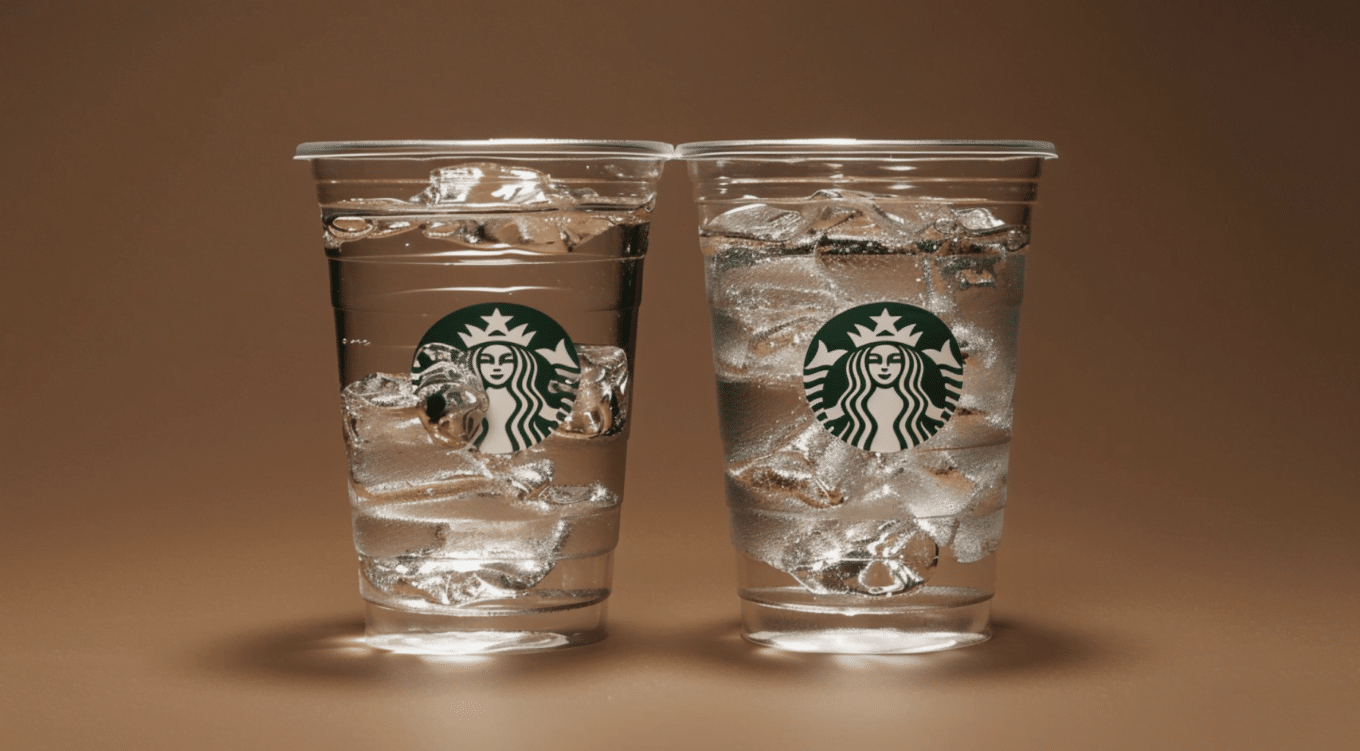Have you ever walked into a Starbucks and wondered if you could get a cup of water for free? You’re not alone.
Many people are unsure about Starbucks’ policy on providing water to customers. The good news is that Starbucks offers all customers free water, regardless of whether they make a purchase.
This comprehensive guide examines Starbucks’ water policy, including how to get free water, any exceptions to the policy, and tips for ensuring a positive experience.
We’ll also explore how this policy fits Starbucks’ sustainability and customer satisfaction commitment.
By the end of this article, you’ll clearly understand how to stay hydrated during your next visit to Starbucks.
Free Water Policy for Everyone at Starbucks
Starbucks has a simple yet commendable policy regarding water: any customer or visitor can request a cup of water at no charge.
This policy stems from the company’s commitment to customer service and well-being.
The company recognizes the importance of water for health and wellness, and they’ve prioritized providing this basic necessity to all.
Whether you’re a regular customer or just passing by, Starbucks will offer you a refreshing cup of water without any obligation to buy anything.
Bottled and Flavored Water Options at Starbucks

In addition to offering free tap water, Starbucks also provides a range of bottled and flavored water options for customers who prefer these alternatives.
These choices add variety and convenience to the hydration selection at Starbucks, catering to different tastes and preferences.
Regarding bottled water, Starbucks offers well-known brands such as Evian and Smartwater. These premium options come at a cost but provide a reliable and portable hydration solution for those on the go.
Starbucks also sells its brand of bottled water, which is a more affordable choice for budget-conscious customers.
Starbucks offers a selection of infused waters, like the popular Strawberry Water, for those seeking a bit of flavor in their water.
These refreshing beverages offer a hint of natural fruit essence without adding sugars or artificial sweeteners, making them a healthier alternative to sugary drinks.
The price of flavored waters may vary slightly depending on the location and size of the drink.
Customers can choose between still and sparkling water options, depending on their preferences.
Seasonal or limited-time flavors may also be available, adding an element of excitement and novelty to the water selection.
It’s worth noting that the availability of specific bottled and flavored water products may differ across regions, particularly in international markets where local tastes and preferences are considered.
However, Starbucks strives to offer a consistent range of hydration options to keep its customers refreshed and satisfied, no matter where they are.
Water Quality and Filtration at Starbucks
Starbucks is known for its high-quality beverages, and the foundation of this quality lies in the water they use.
The company values water filtration and treatment to ensure that every cup of coffee or tea tastes its best.
To achieve this, Starbucks employs advanced filtration systems across its locations. These systems typically include activated carbon filters and reverse osmosis technology, which work together to remove impurities, chlorine, and other contaminants that can affect the taste and odor of the water.
This multi-step filtration process results in clean, clear water that allows the natural flavors of the coffee or tea to shine through.
In addition to filtration, Starbucks also focuses on temperature control and mineral balancing. The water temperature used in brewing is carefully regulated to optimize extraction and ensure consistent flavor.
Starbucks also adjusts the mineral content of the water to achieve the ideal balance for beverage preparation. This attention to detail contributes to their drinks’ superior taste and mouthfeel.
Starbucks conducts regular water quality testing at their locations to maintain these high standards. This testing ensures compliance with health and safety regulations and helps identify any issues that may affect the taste or safety of the water.
The company also invests in maintaining its filtration and temperature control equipment to ensure consistent performance.
The impact of water quality on beverage taste cannot be overstated. By prioritizing water filtration, temperature control, and mineral balancing, Starbucks can deliver a consistently excellent experience to their customers, no matter which location they visit.
Starbucks strongly emphasizes education and training for its staff members regarding water quality.
Starbucks’ Water Conservation Goals
Starbucks has set ambitious goals for reducing water usage and enhancing sustainability by 2030, reflecting its commitment to becoming a resource-positive company.
The overarching aim is to conserve or replenish 50% of the water used in its operations and supply chain, demonstrating its dedication to environmental stewardship.
By 2030, Starbucks aims to significantly reduce water usage in its direct operations, stores, and agricultural supply chain compared to a baseline year.
These goals are crucial in addressing global environmental challenges and showcase Starbucks’ corporate responsibility.
Starbucks is implementing innovative methods to reduce water usage to reach these targets. These include improved irrigation techniques, water-efficient crops, and advanced water recycling technologies.
The company also partners with suppliers to enforce water conservation practices and integrates these practices through its C.A.F.E. (Coffee and Farmer Equity) Practices.
Starbucks focuses on targeted efforts in high-risk water basins, where water scarcity poses significant challenges to local communities and ecosystems.
These initiatives include watershed restoration, community education on water conservation, and collaborations with local and international NGOs to improve water availability and quality.
Starbucks measures and reports on the impact of its water conservation efforts through third-party evaluations and sustainability reports.
The company has received recognition and certifications for its water stewardship, acknowledging its commitment to sustainable practices.
These efforts contribute to the company’s long-term success and have a positive impact on the communities and ecosystems in which it operates.
Conclusion
In conclusion, Starbucks’ water policy reflects the company’s commitment to customer satisfaction, sustainability, and high-quality beverages.
By offering free water, implementing advanced filtration systems, and setting ambitious conservation goals, Starbucks demonstrates its dedication to providing a positive customer experience while minimizing its environmental impact.
Next time you visit Starbucks, remember that you can enjoy a refreshing cup of water at no cost. The company is working hard behind the scenes to ensure its quality and sustainability.
If you found this guide informative, we encourage you to explore Starbucks’ sustainability initiatives more on our blog.
Don’t forget to share your thoughts and experiences with Starbucks’ water policy in the comments section below. Stay hydrated, and thanks for reading!




